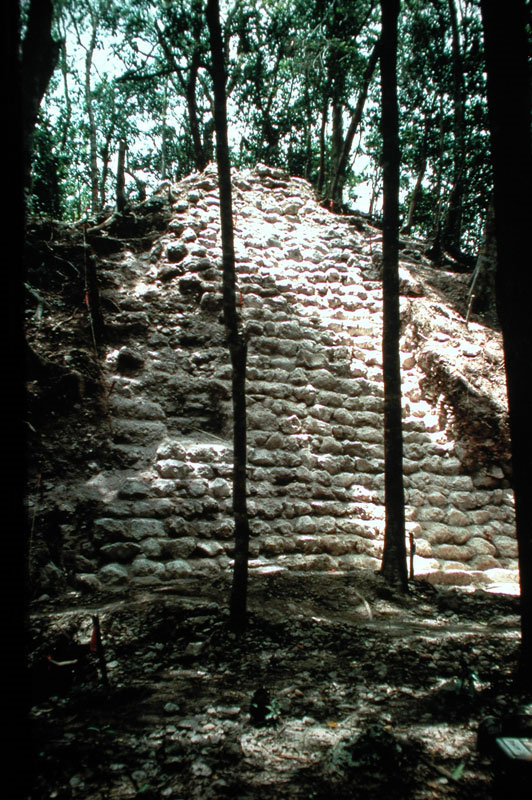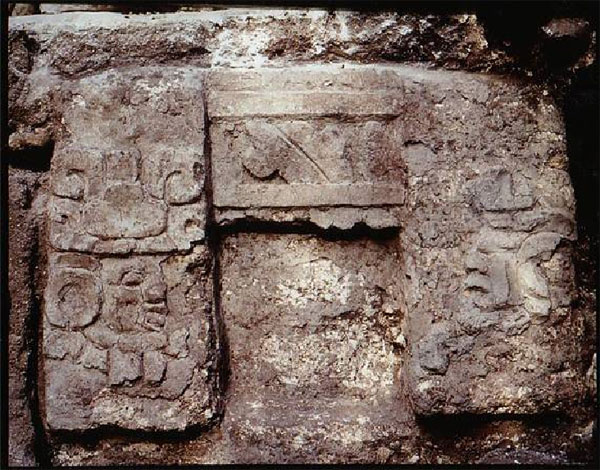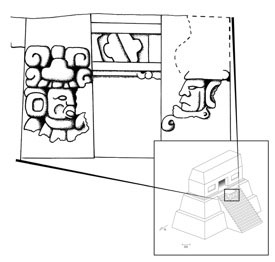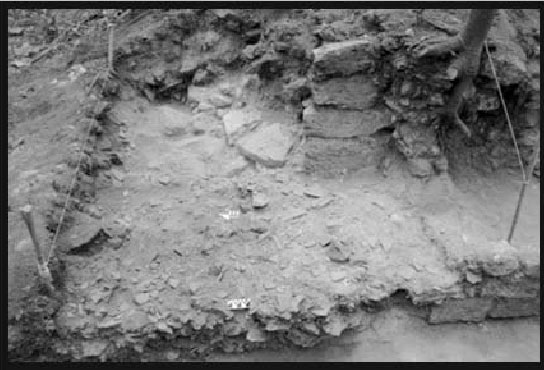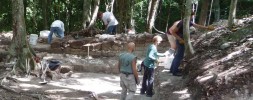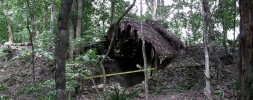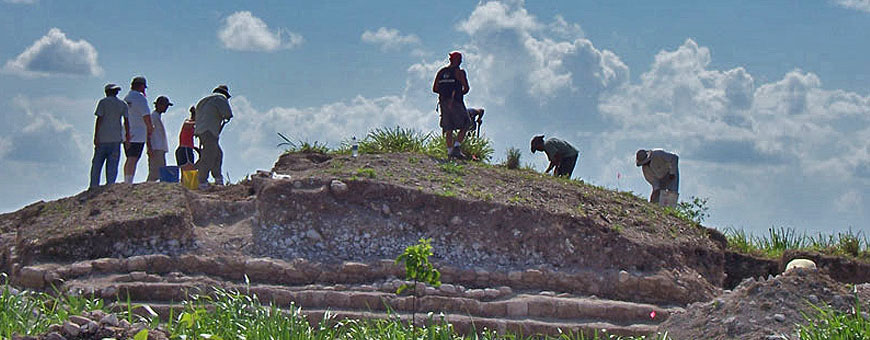
Excavations at Blue Creek. Photo: Maya Research Program
By Dr. Thomas Guderjan and Colleen Hanratty
In 1992 the Maya Research Program began work at Blue Creek, Belize, expanding over a twenty year period to encompass a multi-disciplinary team of researchers. A yearly summer field project of excavation and survey brings together students and volunteers from around the world, to help advance our understanding of Maya society.
Blue Creek is located on the Rio Bravo escarpment in north-western Belize. Despite its modest size, the strategic location at the head of the Rio Hondo afforded its rulers substantial wealth, prestige, and authority. At its peak from 200-600 AD it was a successful city state supporting up to 20,000 inhabitants. Trade and agriculture formed the basis of wealth for Blue Creek leading to a relatively stable social system. However, by 800 AD a major decline is evident with building construction at the core area coming to a halt. By 1100 AD the site was almost completely abandoned.
Early Classic
In the Early Classic (200-600AD), Plaza A (see Map 2) was surrounded by ritual and multifunctional structures on three sides, leaving an open view of the agricultural fields and settlements to the east. Structure 1, the earliest documented columned superstructure in the southern lowlands, dominated this plaza. In addition, a ball court was built on a separate platform nearby.
Plaza B was dominated by the royal palace in the Early Classic and is flanked to the north and south by temple pyramids. Structure 9, a typical Peten-style temple with a single room superstructure positioned atop a steeply inclined substructure with a central staircase. In the Early Classic, a staircase outset near its summit was adorned with a stucco frieze depicting a set of ahaw images. This popul na – an ascension house for rulership – was not only the geographical centre of the site but also served as its axis mundi.
Blue Creek’s socio-political structure changed during the sixth century perhaps in part due to the wider hiatus within the Maya world relating to power and trade. It was during this period that a massive caching event occurred around AD550 at Structure 4 on Plaza A (see Map 2). In preparation for this deposition ritual a large part of the building was removed and a masonry-lined shaft constructed. Caches were placed around the shaft, including more than 100 ceramic vessels.
Within the shaft itself, the recovered artefacts included nearly nine pounds of worked jades, shells, and a chert eccentric (an elaborately shaped artefact) representing a major act of wealth sacrifice. The shaft was then capped with a carved limestone bannerstone/stelae and an uncarved stelae. After this ritual event that represents in a physical form the changes that are happening the wider society, the flow of jade and other imported items into Blue Creek decreases dramatically.
Late Classic
The Late Classic (600-900AD) political reorganization becomes reflected in the construction activities within the site core with Structure 9 being razed and reoriented by a new controlling elite. A new phase of construction reorients the structure 180 degrees and covers the previous Early Classic stucco frieze. Across the Main Plaza, the columnated superstructure of Structure 1 was demolished and a flat platform was built to accommodate the tomb of an important member of this new Blue Creek elite. During this same period, Structures 2 and 3 were constructed, enclosing the eastern portion of Plaza A.
During the Late Classic period significant population growth took place at Blue Creek. In addition to the expansion of the elite residences within the site core, it was during the Late Classic period that 85% of all constructional activities occurred within Kin Tan – a series of elite residences directly west of the site core (see Map 3). Such residential expansions occurred in proximity to high quality agricultural lands with the exception of U Xulil Beh. This low status residential group was constructed solely in the Late Classic in a marginal agricultural setting with poor agricultural potential. It is likely that existing communities already held power over the more productive lands forcing the inhabitants of U Xulil Beh to occupy these less productive agricultural fields.
The amount of land under cultivation peaked during the Late Classic. The large ditched agricultural systems below the escarpment had been in place for several hundred years. However, growing platforms were built at the base of the escarpment near the ditched fields to expand the amount of productive land. West and above the escarpment, the bajos separating residential components had also been cultivated for generations. In the Late Classic, however, terracing and cross-drainage features were built to expand the amount of arable land. Despite the high energetic effort placed into the construction of these features, they expanded Blue Creek’s agricultural potential by less than five per cent. The amount of arable land within Blue Creek – at least 40% of the site’s total 100 square km area – was more than adequate for subsistence agriculture, even for this growing population of between 15-20,000. However, recent research has revealed that expansion may have been driven by a drop in productivity due to soil erosion and decline of soil quality.
Terminal Classic
By the Terminal Classic (800-1100AD), Blue Creek’s political structure had profoundly changed. Construction activities within the site core and adjacent residential areas, such as Kin Tan, came to an abrupt halt. Ultimately, the Terminal Classic is marked by the abandonment and termination of sacred structures, both within the site core and within its most elite residences. In the central precinct, for example, large quantities of broken ceramics and other portable goods were deposited on the front of a shrine associated with Structure 3, representing the final event within the site core. The central precinct was subsequently abandoned.
During this same period, large deposits of broken ceramics and broken portable objects such as manos, metates, obsidian blades, and bifaces were deposited against the baseline of buildings within the Structure 13 Courtyard. In addition, smaller terminal deposits have been recovered from the Structure 19 Courtyard. Again, these deposits mark the final cultural event within these palace complexes and these groups too were subsequently abandoned.
Also during the Terminal Classic, large amounts of broken ceramics and portable goods were deposited against the baselines of buildings within Kín Tan. Within the Structure 37 Plazuela, dense deposits were recovered from the baseline of 3 of the group’s 7 structures – including this group’s sacred ancestral shrine – Structure 34. The terminal deposits recovered included over 22,000 sherds weighing 393 kilogrammes. Intermixed with these broken vessels were 203 special finds such as broken bifaces, manos, metates, obsidian blades, and figurines.
Within the Structure 47 Courtyard, a large terminal deposit was also recovered from its centrally placed ancestral shrine (Structure 50). All told over 15,000 sherds weighing 349 kilogrammes were recovered from the north-west corner of the shrine. Intermixed with these broken vessels were 28 special finds such as broken bifaces, manos, metates, obsidian blades, and beads. In addition, a terminal deposit was recovered from the J14 Courtyard and shares the same characteristics of the other residential terminal deposits.
As within Blue Creek’s central precinct and palace complexes these terminal deposits mark the final act of the society within Kin Tan and the building groups were subsequently abandoned. While construction activities within the site core and adjacent elite residences came to a halt at the end of the Late Classic and then abandoned during the Terminal Classic, some small-scale elite residential constructions took place approximately 3.5 kilometres north-west of the central precinct.
Abandonment
Rosita is one such construction that consists of at least 20 structures built from Late Preclassic to the Classic. All the residences are arranged in groups that surround a large non-residential central structure, which served as an administrative centre for localized resource control. One such residential room was altered during the Terminal Classic and replaced with a distinctive circular Yucatecan style shrine. However, this was a makeshift construction that only involved stripping the masonry façade from the major building in the group. At approximately the same time, a set of rooms was added to the summit of Structure 6. Two Daylight Orange: Darknight Variety vessels, which are a distinctive ceramic from this period, were cached beneath the floor of this superstructure. A third Daylight Orange: Darknight Variety cache was recovered in a bench in the nearby Structure 9. These caching deposits mark the final acts within this group of structures with Rosita abandoned soon after.
Despite extensive testing throughout the settlement zone of Blue Creek over the past 19 years, the project has only uncovered slight evidence of Post-classic occupation. Ceramics recovered from the surface of Structure U-5 at the base of the escarpment, and from the Rempel Group on the bank of the Rio Bravo, indicate that a small residual population still occupied the area. These people may have exploited relic orchards that would have survived with minimal human intervention in the nearby ditched field systems. However, evidence from the Birds of Paradise Fields indicates that by 1100 AD even this small population had abandoned the area and the ditched fields that had been maintained for generations had fallen into disuse.
The Future
This project has grown over the two decades of exploration to encompass a multidisciplinary team of researchers that carry on work to further refine the story of a Maya state. The once simple story of a rise to power and subsequent collapse has now become more complicated and fascinating, with much work still to be done. However, with more projects planned and the preparations under-way for the 2011summer fieldwork , the team hopes to uncover yet more details on the lives of the Maya of Blue Creek.
Tom Guderjan is president of the Maya Research Program and director of the Blue Creek project and a faculty member at the University of Texas at Tyler. His book, The Nature of an Ancient Maya City: Resources, Interaction and Power at Blue Creek, Belize. University of Alabama Press (2007), summarises much of the work done at Blue Creek.
Colleen Hanratty is a doctoral candidate at Southern Methodist University in Dallas. She has done archaeological work in south-eastern and south-western United States, Mexico, Peru and Belize. Her doctoral research is on the elite residences of Blue Creek.
Get Involved
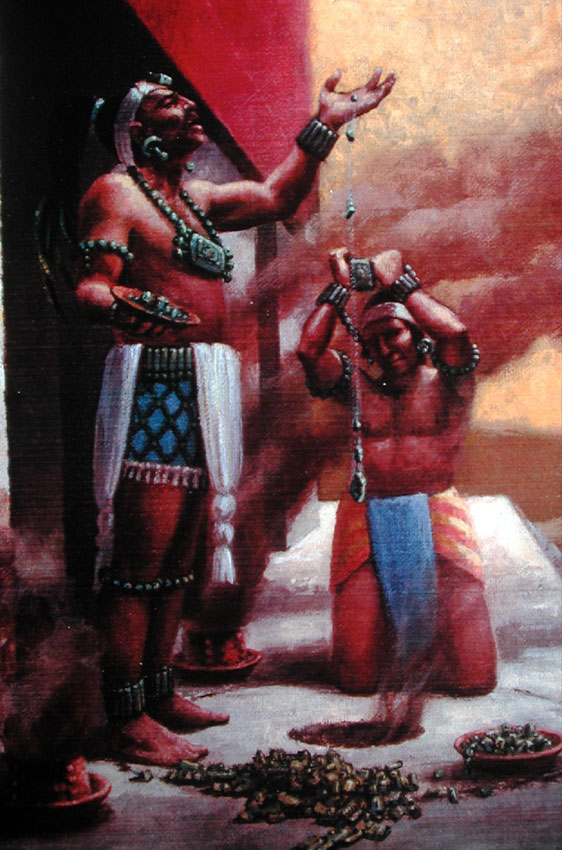
Reconstruction drawing depicting AD 500 caching event at Structure 4 (Courtesy National Geographic Society)
The Maya Research Program is a United States-based non-profit organization that sponsors archaeological and ethnographic research in Meso-America. Each summer since 1992 they have sponsored archaeological fieldwork at the ancient Maya site of Blue Creek in north-western Belize. In 2011 they again offer opportunities to participate in their field programme and learn about the Maya of the past and today. The Blue Creek project is open to student and non-student participants, regardless of experience. Participants will receive training in archaeological field and laboratory techniques. Academic credit and scholarships are available.
2011 Field Season Dates:
Session 1: Monday May 23 – Sunday June 5
Session 2: Monday June 6 – Sunday June 18
Session 3: Monday June 27 – Sunday July 10
Session 4: Monday July 11 – Sunday July 24
For additional information please contact the Maya Research Program:
Web: www.mayaresearchprogram.org
Email: mrpinquiries@gmail.com
Photographs and illustrations courtesy of the Maya Research Program.
Learn more
Comments
 Logging you in...
Logging you in... Post a new comment
Comments by IntenseDebate
Reply as a Guest, or login:
Go backConnected as (Logout)
Not displayed publicly.
Posting anonymously.

 Loading IntenseDebate Comments...
Loading IntenseDebate Comments...Leave a Reply
Related Posts
Drugs barons accused of destroying Guatemala’s rainforest
14/06/2011 • Environmentalists say settlers working for drug traffickers to build airstrips have burned down huge tracts of rainforest damaging ecology and archaeology. ...more>
Chum Balam-Nal
01/02/2010 • The Maya Research Program uncovers Chum Balam-Nal, a residential zone at Blue Creek in Belize ...more>
Colouring the Past at El Pilar
11/01/2009 • Research at El Pilar centres on settlement patterns, environmental management, and the everyday people of the Maya civilisation ...more>



